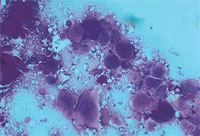|
| Fig. 3.5 A positive Tzanck preparation demonstrating large multinucleated keratinocytes. The nuclei of normal keratinocytes are the size of neutrophils, which are the other cells present in this preparation. (Courtesy of James E. Fitzpatrick, MD.) |
A Tzanck smear is a standard technique for the rapid diagnosis of herpes simplex virus (HSV) or varicellazoster virus (VZV) infections. It cannot distinguish between these two agents, nor can it distinguish between HSV subtypes (HSV type 1 or 2). It is performed by scraping the base of a fresh blister with a scalpel blade and then spreading the adhering cells and material onto a glass slide. The slide is then stained with a Giemsa, Wright, or Sedi stain. The typical multinucleated giant cells or atypical keratinocytes with large nuclei are then easily visualized (Fig. 3-5).
Nahass GT, Goldstein BA, Zu WY, et al: Comparison of Tzanck smear, viral culture, and DNA diagnostic methods in detection of herpes simplex virus and varicella-zoster infection,
JAMA 268:2541–2544, 1992.
